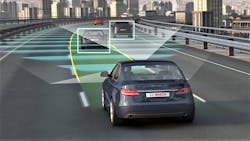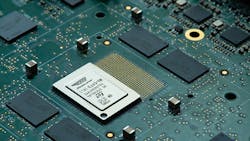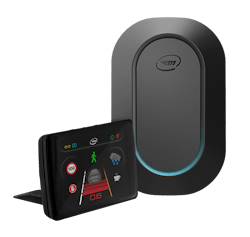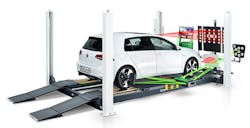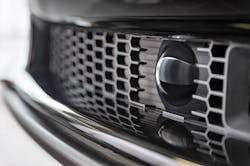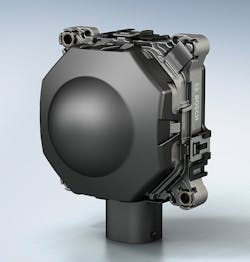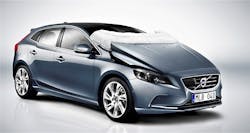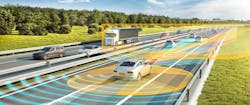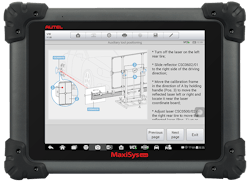Advancement in automotive electronics is growing in leaps and bounds
Electronics make up a significant portion of any automobile made in the last 35 years. starting in the 1980s with the widespread replacement of carburetors with early electronic fuel injection. Today, advanced driver-assist systems (ADAS) are one of the fastest-growing segments in automotive electronics and are the precursor technology to fully autonomous driving vehicles. One example of advanced ADAS electronics is Mobileye's EyeQ technology, which is used by 27 OEMs on 40 million automobiles worldwide. Mobileye is an Intel Company that manufactures the EyeQ vision-processor System-on-Chip. EyeQ vision processors constantly monitor the driving scene in front of a vehicle and alert the driver of an impending accident with another car, pedestrian, bicyclist, or motorcycle. The EyeQ system is also capable of detecting speed limit signs and, controlling the vehicle's high and low headlight beams during night driving. Future-generation Mobileye devices will include camera-only automatic electronic braking, as well as various features enabled by self-driving technologies. Mobileye also makes retrofit systems for heavy-duty truck fleets.
Early ADAS systems include anti-lock brakes, stability control, and traction control. It is estimated that around 80% of vehicles today have at least one driver assistance system. Consumer surveys show that the car-buying public is becoming increasingly more interested in ADAS applications that offer driver comfort, safety, and convenience. In this article, we will take a look at two ADAS systems: driver alert and collision avoidance.
The increased usage of ADAS will have a significant impact on the auto repair industry as well. Even a simple job like replacing a windshield or bumper is complicated by the presence of ADAS sensors that need to be re-calibrated. Companies like Autel, that manufacture the MaxiSys ADAS Calibration Tool, and Bosch, who sell their DAS 1000 Calibration Set offer potential revenues for independent repair shops who will, in turn, have to educate consumers regarding increased costs for windshield replacement and/or accident repair.
Sleepy Driver Alert Systems…A voice of reason
Wake up!, Anti-sleep pilot, Driver Condition Monitor, Fatigue Detection, or Tiredness Detection Warning are some of the names of systems that warn a driver that they are not paying attention to the road ahead—time to get some coffee or pull over and take a nap. Studies have shown that an estimated 21 percent of fatal crashes, 13 percent of crashes resulting in severe injury and 6 percent of all crashes, involve a drowsy driver. Becoming sleepy while driving creates issues that can cause bad things to happen. Sleepiness reduces reaction time, vigilance, concentration, and alertness that all effect attention-based driving activities. Besides, the quality of decision-making is affected by slower information processing. Studies in the U.S. and Europe have identified young, male drivers, under 30 years old, as a high-risk group that is involved in sleep-related accidents. The demographic is between 21 to 25 years old and is another factor in high insurance rates for this age group. Also, sleep-related accidents tend to be more frequent between the hours of 2:00 a.m. to 6 a.m. and in mid-afternoon between 3:00 p.m. and 4:00 p.m.
There are four types of systems used in driver fatigue detection systems. Steering pattern monitoring uses input from a steering wheel sensor or input from an electric power steering system. These systems focus on monitoring steering wheel movements and deviations from the lane position to detect sudden or excessive corrections in the direction the vehicle is traveling. These inputs can trigger a driver alert if they become too frequent.
Another system uses a lane monitoring camera and works only when a driver is steering the vehicle, vs. an automatic lane-keeping system. On-board artificial Intelligence (AI) uses smart learning about driver behavior and can react to keep the driver alert. For example, if a vehicle receives frequent lane departure warnings, the system can alert the driver that it’s time to pull over to take a break.
Driver eye/face monitoring is another technology used to detect driver fatigue. These systems use a camera to observe the driver’s face, and in real-time determine the driver’s physical and mental condition based on its driver-face image database. The driver's state of alertness can be estimated from eye closure frequency, blinking, gaze direction, yawning, and head rotation. These systems will sound an alarm when the driver reaches a hypo vigilance state that indicates fatigue and/or distraction. Hypo vigilance is defined as an enhanced state of sensory sensitivity and anxiety that often leads quickly to exhaustion.
A fourth technology to determine driver alertness is a physiological measurement that requires body sensors to measure parameters like brain activity, heart rate, skin conductance, and muscle activity. The reliability and accuracy of driver drowsiness detection by using physiological, or body measurement signals is higher when compared to face-monitoring cameras. However, the intrusive nature of measuring physiological signals remains an issue. Just imagine, a driver would shave their head and place a dozen electrodes on their scalp to monitor brain activity (or lack thereof) and place other sensors on their chest to measure heart rate—who wouldn’t want to look like a science experiment while driving down the highway? Instead, researches are exploring the use of sensors/electrodes placed on steering wheels and/or within the driver's seat as a more practical way to take these measurements.
While these four types of technologies can be used as a stand-alone system, it’s more likely that they will be used in combination. For example, too many large steering inputs combined with too many eye blinks and excessive drifting into adjacent lanes of traffic would trigger a “stay-awake” alert.
Forward Collision Warning
Most drivers like to think that they are careful, attentive, and have the driving skills to keep from running into other vehicles. And yet, automobile drivers are human (or at least until fully-autonomous cars are on the road) and humans, even the most skilled driving humans make mistakes. While driving we can become tired, distracted, or misjudge the speed and distance of other vehicles around us, all resulting in a potential accident—and that doesn’t include all the other drivers on the road that are of course, less skilled than we are. It would great if we had just a little help keeping us safe on the highway.
Not to state the obvious, but not having an automobile accident has many advantages including one's car or truck looks better—no dings, dents, scratches on the paint, and/or no missing parts; one doesn’t have to visit the body shop—body shop work is never planned, routine maintenance; lower insurance rates—getting too many fender-benders results in high premiums and/or no insurance coverage and finally, less driver/passenger stress—we have all ridden as a passenger with a driver that is constantly a hair's breadth away from running into another vehicle.
The basic concept that two vehicles should never try to occupy the same space at the same time is what forward collision warning (FCW) systems are all about. OEMs are consistent in that they all choose a different name for their collision avoidance systems like Ford Forward Alert; BMW Pedestrian Warning with City Brake Activation; Mitsubishi Forward Collision Mitigation; Chrysler Full Speed Forward Collision Warning Plus, and of course Star Trek’s Full Warp Speed Ahead—don’t run into a stray planet.
The Bosch LRR4, fourth generation, long-range radar sensor can detect other vehicles at a distance of 820 feet (250 meters). It can be used as part of FCW systems, adaptive cruise control, and other ADAS systems. (Picture courtesy of Bosch)
Forward Collision Warning systems have been around for a few years, mostly on high-end luxury cars. It has only been in the last few years that these systems can detect pedestrians; automatically apply the brakes and use electronic steering to swerve around vehicles or other objects. Today FCW systems are offered on more mainstream, lower-cost vehicles. It's only a matter of time before some form of FCW will be required on all new cars. For example, the United States and the European Union are mandating that all vehicles be equipped with autonomous emergency braking and forward-collision warning systems by 2022. This is no different than past mandated safety technology like: seat belts, ABS braking systems, airbags, and tire pressure monitoring systems.
The most basic of FCW systems monitor a vehicle's speed, the speed of vehicles ahead, and the distance between them. The system's computer does the "math" and if parameters reach a level where it is determined that a collision is about to happen, the system sounds a warning to the driver and/or on some vehicles applies the brakes in certain circumstances.
Depending on the manufacturer, several technologies are used for FCW systems including radar, lidar, and cameras. Soon, when vehicles are wirelessly connected to the driving environment, GPS sensors will detect fixed dangers like stop signs, railroad crossings, lane merging, and others. Radar is also known as "echo ranging," where a high-frequency light, audio frequency, or radiofrequency pulse is sent out by the vehicle's radar collision avoidance sensor. If the pulse strikes an object it reflects part of the pulse energy to return to the radar emitter where it is detected. The difference in time between when the detection pulse was sent out and the arrival of the reflected wave is then used to calculate the speed, and/or range, or distance to the object.
Light imaging, detection, and ranging (Lidar) works on the same principle as radar but uses light energy to illuminate an object. The difference in the return time and the wavelength is used by the system to create a 3-dimensional representation of the target or object. Lidar, also known as 3D laser scanning, was originally used to make high-resolution maps and has been adapted for use in ADAS systems. Lidar can sense objects as far away as 600 feet (200 meters) and because of its high energy avoids most radio frequency interference. However, the downside is that it can take inaccurate readings from objects that have poor or no reflectivity—like clothing worn by pedestrians.
Using an onboard camera (or stereo-view cameras) is another method to detect surrounding vehicles or pedestrians. The camera produces a digital image that a computer extracts dimensional data from and converts to numerical, or symbolic information. This process is known as computer vision and is the analysis and understanding of information from a single image or a sequence of images. The computer compares digital images to a database and determines what an object is and what to do about its presence, i.e. sound an alert and/or apply the brakes.
Other life-saving countermeasures
On some vehicles, similar technology offers collision avoidance for pedestrians. As early as 2004, Honda’s Intelligent Night Vision is a system that detects pedestrians in front of a vehicle and alerts the driver. In the event of a collision with a pedestrian, the Volvo V40 uses seven sensors embedded in the front of the car that transmit signals to a control unit. The control unit evaluates the signals, and if it registers what it interprets as the vehicle running into a human leg, the pedestrian airbag is deployed. The hood hinges are each equipped with pyrotechnical release mechanisms which, when the system is activated, pull out a pin and release the rear of the hood panel. At the same time, an airbag is activated in front of the windshield. During the inflation sequence, the airbag raises the hood 4 inches (10 cm) and it remains in the raised position. The gap between the raised hood and the engine creates a space for the hood to deform and provide a dampening effect when it is struck by a pedestrian.
The use of ADAS that helps drivers with steering, braking, monitoring, and warning tasks is expected to increase over the next 10 years. In part this increase in advanced driving technology will be driven by the automobile insurance industry; consumer advocacy groups and the government to provide safety applications that protect drivers, pedestrians, and reduces accidents. Is your shop prepared?
Because ADAS technology can be critical in providing drivers forward collision, lane departure, and pedestrian alerts, and on some systems automatically activate the vehicle’s braking system, it is paramount that it functions properly. Many factors can cause an ADAS system to be knocked out of calibration including collisions (even a minor fender-bender), windshield replacement, wheel alignment, and suspension repairs. Other factors affecting calibration include sensor mounting bracket removal or replacement; changes in tire size; front airbag(s) deployed or ADAS-related DTCs set. ADAS systems have to be properly calibrated to gauge speed and distance that are critical to their performance.
A technician uses wheel clamps and lasers to set up the Autel Calibration Frame level and parallel to the vehicle. The frame holds OEM targets used to calibrate radar and camera sensors. (Picture courtesy of Autel)
For example, a vehicle is involved in a minor accident that affects the front grill knocking the forward-facing radar unit out of calibration (not pointing to where it’s supposed to) could result in a misapplication of automatic braking. If the radar sensor is pointed up (even by a few degrees) the forward-collision warning system could interpret a bridge as a stopped vehicle and as the driver approaches the bridge, the ADAS system applies the brakes. Automakers recommend recalibration of ADAS sensors after collision repairs that also include a diagnostic scan before and after any work performed on these systems.
Autel is an international company that manufactures professional, OEM-level, ADAS calibration equipment for the automotive aftermarket. Their ADAS Complete Frame Targets Calibration Package for All Sensors, combined with their MaxiSys ADAS calibration tablet, provides independent shops the ability to work effectively on ADAS systems. The calibration packages include a frame that holds target pattern boards, sliding target crossbar, wheel clamps, and wheel lasers, and vehicle-specific target boards.
With the vehicle level, wheel clamps with lasers are attached. This allows the technician to adjust the calibration frame parallel to the vehicle. The Autel MaxiSys tablet with ADAS calibration module offers technicians video and graphical step-by-step guidance for setting up and calibration procedures. The MaxiSys tablet instructs the technician as to which targets to use and the OEM procedure required for camera, radar, or night vision calibration. With insurance companies paying between $200 to $300 for each ADAS calibration, and $100 to $150 for pre and post diagnostics, independent shops can justify the cost of this equipment.
The technological advancements that make up the systems representing ADAS, are here to stay and, are bringing society ever-closer to the full-autonomous vehicle. Encounters with these systems can no longer be avoided as they have virtually infiltrated every system on today’s modern vehicles. The time is never better than right now, to get the necessary training, information and tooling to see the prosperity of your business, well into the future.
